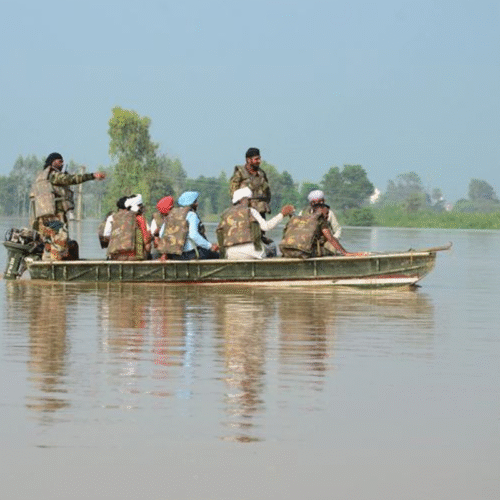CHANDIGARH – A catastrophic flood situation has gripped Punjab, claiming at least 23 lives and leaving a trail of destruction across 1,018 villages. Over the past week, rescue teams have managed to evacuate 16,039 people from inundated areas, but thousands remain stranded in eight severely affected districts.
Widespread Devastation and Rescue Operations: The scale of the disaster is staggering, with deaths reported in Pathankot (8), Hoshiarpur (7), Rupnagar (3), Barnala (3), and Gurdaspur (2). Most victims were either swept away by the raging currents of the Ravi, Beas, and Sutlej rivers or died after their houses collapsed. The state’s Aam Aadmi Party (AAP) government is working with the Army, BSF, Air Force, and the National Disaster Response Force (NDRF) to accelerate rescue and relief efforts.
Chief Minister Bhagwant Mann chaired a high-level meeting to assess the situation and has constituted a high-powered committee to oversee the operations. He directed Chief Secretary KAP Sinha to speed up relief work, noting that the unprecedented discharge of 14.11 lakh cusecs of water in the Ravi caused the most significant damage.
Emerging Threats and Ongoing Challenges: While some areas are finally seeing relief, new threats are emerging. Water levels in the Ravi and Beas rivers have begun to recede in the Majha and Doaba regions, but the Ghaggar, Tangri, and Markanda rivulets are now in spate. Water surged down the Ghaggar following overnight rain, putting districts like Patiala and Sangrur on alert. By the evening, the Patiala administration was on high alert as water flowed toward Sardulgarh, exceeding the 30,000 cusecs mark.
Another area of concern is Dharamkot in Gurdaspur, where the Ravi river continues to flow at 4.60 lakh cusecs, well above the danger level. The civil administration and central forces are continuing rescue operations in the 323 affected villages in Gurdaspur and 81 in Pathankot.
Political Unity and Water Diplomacy: In a show of political unity, leaders from various parties, including AAP, BJP, Congress, and SAD, have visited the affected districts, urging their cadres to assist in relief efforts. Farmer unions are also actively involved in rescue and relief work.
The state government has also been engaged in a diplomatic effort with its neighbors. On August 22, Punjab wrote to Haryana and Rajasthan, urging them to accept additional floodwaters. While Haryana initially did not respond, a senior official confirmed receiving a letter from a Haryana official asking Punjab to slow down the release of water as their own rivers were now in spate. Meanwhile, water levels in major dams—Pong, Ranjit Sagar, and Bhakra—have begun receding, though the Pong Dam remains at a critical level of 1,391 feet, necessitating controlled water releases.


